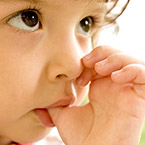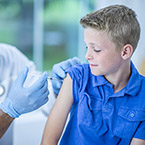Winter 2020
Does Your Child Get Enough Sleep?
 Here’s a fact that has parents, teachers and doctors concerned: less than half of all school-age kids get enough sleep most weeknights. The American Academy of Pediatrics recommends that children ages 6 to 12 get between 9 and 12 hours of sleep each night, and that teens get 8 to 10 hours. But a recent study revealed that only 48% of school-age kids get at least 9 hours of sleep per night during the school week.
Here’s a fact that has parents, teachers and doctors concerned: less than half of all school-age kids get enough sleep most weeknights. The American Academy of Pediatrics recommends that children ages 6 to 12 get between 9 and 12 hours of sleep each night, and that teens get 8 to 10 hours. But a recent study revealed that only 48% of school-age kids get at least 9 hours of sleep per night during the school week.
Quality sleep provides huge benefits. Children who regularly get enough sleep have healthier immune systems and better overall mental health. They have sharper memories and better behavior, which are key to success in school.
Kids who do not get enough sleep are more apt to suffer from physical and emotional problems. A lack of sleep affects mood and concentration, and can lead to health issues like headaches, obesity and depression. Not getting enough quality sleep makes it tougher for kids to cope with life — both at home and at school.
The good news is that parents can ensure their kids get enough sleep by helping them practice what’s known as ‘sleep hygiene.’ Sleep hygiene refers to tried-and-true habits and routines that make it easier for kids to fall asleep and stay asleep. It includes keeping a consistent bedtime and wake time, and ensuring a child’s bedroom is dark, cool, quiet and comfortable. And for younger kids, it helps to have a soothing ritual before bed such as taking a bath, putting on cozy pajamas, brushing teeth and reading a story.
For kids of all ages, getting plenty of exercise and spending time outside during the day can help them get a deep and restful sleep at night. However, in the hour or so before bed, avoid exercise or high-energy activities, including rough-housing. Give your child a chance to unwind and relax.
Also avoid screen time starting an hour before bed, and don’t allow screens in your child’s bedroom at night. This includes TVs, computers and phones. Many families find that having their tweens and teens surrender their phones at night really helps their kids get to sleep faster and stay asleep.
For your family’s overall happiness and wellbeing, healthy sleep habits are a worthwhile investment!
Sledding Safety
 Snow sledding is fun for the whole family, as long as it’s done safely! Ski areas offer the best sledding thanks to long, thrilling runs that are well-maintained and free of obstacles.
Snow sledding is fun for the whole family, as long as it’s done safely! Ski areas offer the best sledding thanks to long, thrilling runs that are well-maintained and free of obstacles.
For neighborhood sledding, be sure there are no collision hazards like trees, poles, fences and parked cars. And of course, a sledding path must never intersect a street with car traffic. Helmets are a must: a winter-sport helmet is best, but a bike helmet is better than nothing. And always sled feet first, never head first. Be sure everyone has clothing and gear that keep them warm, dry and comfortable.
Sledding is an all-ages sport, so be sure you’re there to supervise and take some runs yourself!
Cook Up Some Fun with Your Family
 The kitchen has always been a place where families connect. And today, the popularity of YouTube videos and TV cooking-competition shows (including some that feature super-talented kids!) have encouraged many families to use meal planning and preparation as a way to enjoy time together. Plus, creating a menu, grocery shopping and cooking all require organized thinking, careful reading, math calculations and following directions. These are all critical skills that benefit kids for the rest of their lives.
The kitchen has always been a place where families connect. And today, the popularity of YouTube videos and TV cooking-competition shows (including some that feature super-talented kids!) have encouraged many families to use meal planning and preparation as a way to enjoy time together. Plus, creating a menu, grocery shopping and cooking all require organized thinking, careful reading, math calculations and following directions. These are all critical skills that benefit kids for the rest of their lives.
Preparing a healthy meal also makes children aware of the basic food groups. And it’s fun to see how some kids prefer the science of baking — which requires precise measuring and following directions — versus the art of cooking, which often allows for more improvisation and creativity.
So why not invite your child to select a cooking or baking show that you can watch together, or choose a recipe from a kids’ cookbook or an internet recipe site? Try letting them be in charge. You’ll help your child build life skills while you make something delicious and create lasting memories!
Get some tips for healthy family meals from the American Heart Association.
Understanding and Treating Fevers
 A fever is a higher-than-normal body temperature, which is the body’s way of fighting an illness. Normal body temperature is 98.6 degrees Fahrenheit; anything above 100.4 degrees is considered a fever.
A fever is a higher-than-normal body temperature, which is the body’s way of fighting an illness. Normal body temperature is 98.6 degrees Fahrenheit; anything above 100.4 degrees is considered a fever.
If you suspect your child has a fever, take their temperature with a thermometer. Keep in mind that in general, you don’t need to give medicine for a fever itself, unless it’s making your child uncomfortable.
When should you see a doctor for a fever? Do seek medical care if an infant younger than 3 months old has a fever. Regardless of age, a child with a fever higher than 104 degrees should see a doctor, as should any child whose fever lasts more than three days, or any child with a chronic health condition. See our fever page for more reasons to see a doctor for a fever and how to take your child’s temperature.
When is it OK to treat a fever at home? As long as none of the conditions above or in the article apply and the fever is 104 degrees or lower, keep your child lightly dressed and give them lots of fluids in the form of ice chips, popsicles, water, juice or decaf tea. Don’t wrap them in blankets to warm them up or use ice water or rubbing alcohol to cool them down.
If they are uncomfortable, you can give children over 3 months of age acetaminophen (Tylenol). Children over 6 months may take either acetaminophen or ibuprofen (Advil or Motrin). Follow the dosage instructions on the label and use the measuring tool that comes with the medicine.
If you are unsure what to do, call your child’s doctor.
Mindfulness Meditation
 Parents and teachers are discovering the benefits of simple meditation to help ease anxiety and improve behaviors in children. Meditation offers a chance for too-busy brains to ‘unplug’ and relax. This break can help kids function better and think more clearly.
Parents and teachers are discovering the benefits of simple meditation to help ease anxiety and improve behaviors in children. Meditation offers a chance for too-busy brains to ‘unplug’ and relax. This break can help kids function better and think more clearly.
Mindfulness meditation does not have to be linked to any belief system; it can be as simple as practicing deep breathing or concentrating on a certain word, sensation or image. What does the medical community think about this? The American Academy of Pediatrics encourages parents to share meditation time with their children.
Learn about various types of meditation, or try one of the top-rated meditation apps for kids.
Thumbsucking
 While it’s natural for some babies to suck their thumbs, children tend to outgrow the habit between the ages of 2 and 4. But sometimes, kids continue thumbsucking to soothe themselves, and they need some help to quit. This requires us as parents to be positive and encouraging. If it’s a nighttime habit, bandaging the thumb or putting a sock on the hand can help. Sometimes, we also need to identify and fix the source of the discomfort that’s triggering the thumbsucking.
While it’s natural for some babies to suck their thumbs, children tend to outgrow the habit between the ages of 2 and 4. But sometimes, kids continue thumbsucking to soothe themselves, and they need some help to quit. This requires us as parents to be positive and encouraging. If it’s a nighttime habit, bandaging the thumb or putting a sock on the hand can help. Sometimes, we also need to identify and fix the source of the discomfort that’s triggering the thumbsucking.
Since vigorous thumbsucking can cause dental problems, your child’s dentist or doctor can also encourage them to quit — and might prescribe a harmless, bitter-tasting liquid that’s used to coat the thumb.
Learn more about common childhood habits.
HPV Vaccine Timing
 The American Academy of Pediatrics recommends that children ages 11 to 12 get two doses of the human papillomavirus (HPV) vaccine, with the doses given 6 to 12 months apart. For teens who missed getting the vaccine sooner, three doses are recommended.
The American Academy of Pediatrics recommends that children ages 11 to 12 get two doses of the human papillomavirus (HPV) vaccine, with the doses given 6 to 12 months apart. For teens who missed getting the vaccine sooner, three doses are recommended.
Preteens and teens need the vaccine now to prevent certain cancers and conditions when they are adults. The HPV virus is extremely common, and every year in the U.S., HPV-related cancers strike over 30,000 men and women — with 4,000 women dying from cervical cancer annually.
Currently, HPV vaccination rates are low in Washington state: less than 52% of males and females between the ages of 13 and 17 have completed the vaccine series.
Learn more about the HPV vaccine schedule and dosing.
Quick Tip
It’s not too late to get the flu vaccine this year. Flu season usually lasts until April so there’s still time to get protected.